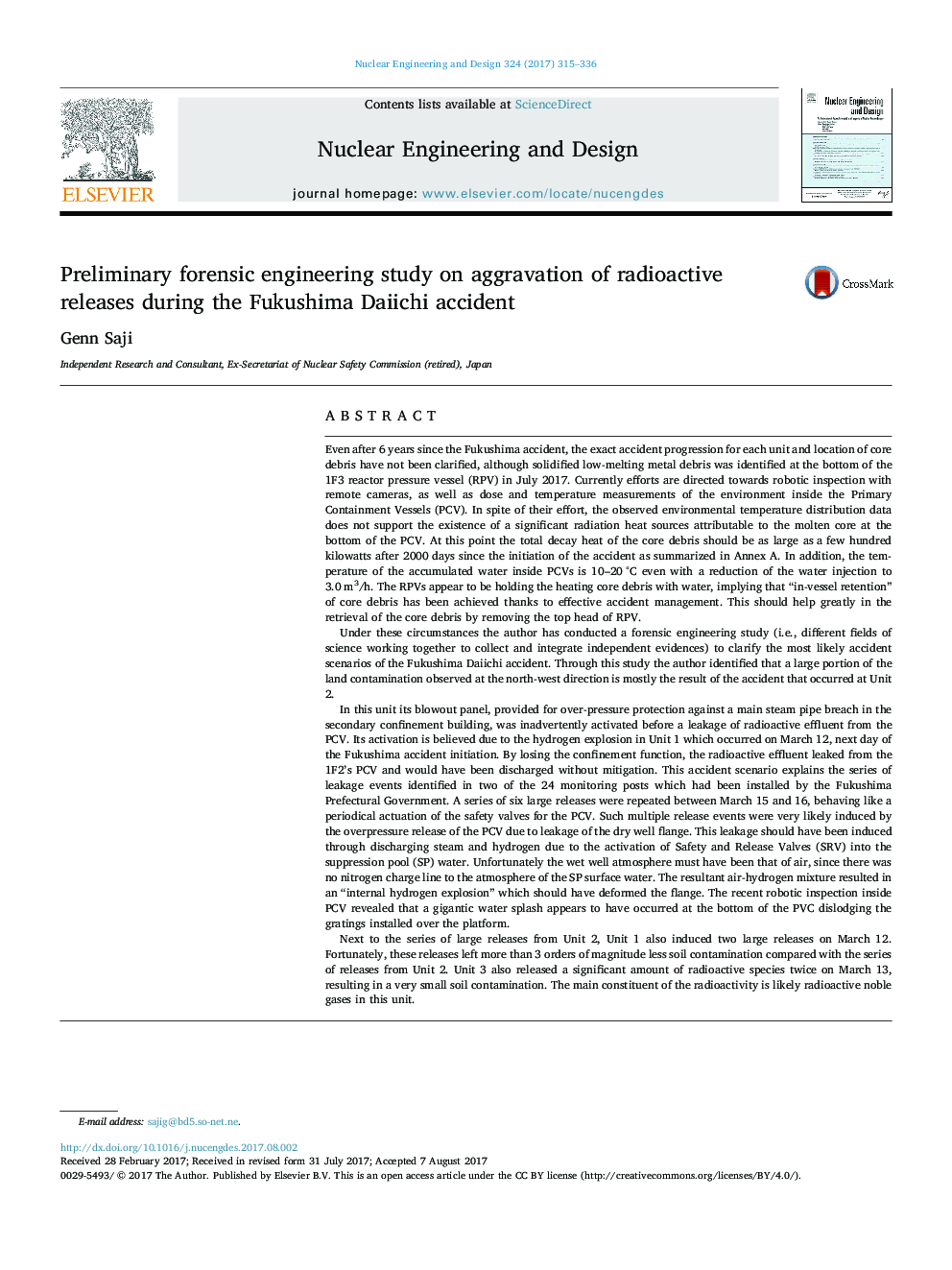| کد مقاله | کد نشریه | سال انتشار | مقاله انگلیسی | نسخه تمام متن |
|---|---|---|---|---|
| 4925376 | 1431397 | 2017 | 22 صفحه PDF | دانلود رایگان |

- Most of the NW land contamination was found induced through bypass leakage from Unit 2.
- Early failure of RCIC was found induced by coincident “small-leak LOCA” and core melt in 1F3.
- The “radiation-induced electrolysis” produced a volume of hydrogen in its reactor vessel.
- The hydrogen explosion at the free air volume of suppression pool occurred in 1F2 on Mach 15.
- The pool water gushed into the containment vessel and impacted the dry well flange to leak.
Even after 6 years since the Fukushima accident, the exact accident progression for each unit and location of core debris have not been clarified, although solidified low-melting metal debris was identified at the bottom of the 1F3 reactor pressure vessel (RPV) in July 2017. Currently efforts are directed towards robotic inspection with remote cameras, as well as dose and temperature measurements of the environment inside the Primary Containment Vessels (PCV). In spite of their effort, the observed environmental temperature distribution data does not support the existence of a significant radiation heat sources attributable to the molten core at the bottom of the PCV. At this point the total decay heat of the core debris should be as large as a few hundred kilowatts after 2000 days since the initiation of the accident as summarized in Annex A. In addition, the temperature of the accumulated water inside PCVs is 10-20 °C even with a reduction of the water injection to 3.0 m3/h. The RPVs appear to be holding the heating core debris with water, implying that “in-vessel retention” of core debris has been achieved thanks to effective accident management. This should help greatly in the retrieval of the core debris by removing the top head of RPV.Under these circumstances the author has conducted a forensic engineering study (i.e., different fields of science working together to collect and integrate independent evidences) to clarify the most likely accident scenarios of the Fukushima Daiichi accident. Through this study the author identified that a large portion of the land contamination observed at the north-west direction is mostly the result of the accident that occurred at Unit 2.In this unit its blowout panel, provided for over-pressure protection against a main steam pipe breach in the secondary confinement building, was inadvertently activated before a leakage of radioactive effluent from the PCV. Its activation is believed due to the hydrogen explosion in Unit 1 which occurred on March 12, next day of the Fukushima accident initiation. By losing the confinement function, the radioactive effluent leaked from the 1F2's PCV and would have been discharged without mitigation. This accident scenario explains the series of leakage events identified in two of the 24 monitoring posts which had been installed by the Fukushima Prefectural Government. A series of six large releases were repeated between March 15 and 16, behaving like a periodical actuation of the safety valves for the PCV. Such multiple release events were very likely induced by the overpressure release of the PCV due to leakage of the dry well flange. This leakage should have been induced through discharging steam and hydrogen due to the activation of Safety and Release Valves (SRV) into the suppression pool (SP) water. Unfortunately the wet well atmosphere must have been that of air, since there was no nitrogen charge line to the atmosphere of the SP surface water. The resultant air-hydrogen mixture resulted in an “internal hydrogen explosion” which should have deformed the flange. The recent robotic inspection inside PCV revealed that a gigantic water splash appears to have occurred at the bottom of the PVC dislodging the gratings installed over the platform.Next to the series of large releases from Unit 2, Unit 1 also induced two large releases on March 12. Fortunately, these releases left more than 3 orders of magnitude less soil contamination compared with the series of releases from Unit 2. Unit 3 also released a significant amount of radioactive species twice on March 13, resulting in a very small soil contamination. The main constituent of the radioactivity is likely radioactive noble gases in this unit.
105
Journal: Nuclear Engineering and Design - Volume 324, 1 December 2017, Pages 315-336